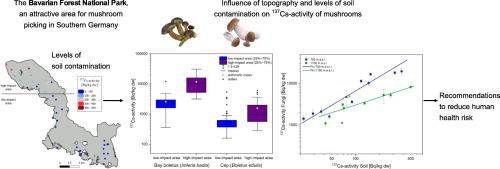Science of the Total Environment ( IF 8.2 ) Pub Date : 2021-10-08 , DOI: 10.1016/j.scitotenv.2021.150861 Anna-Lena Ernst 1 , Gerald Reiter 2 , Meike Piepenbring 3 , Claus Bässler 4

|
The radioactive contamination of edible mushrooms increases human health hazards, especially in high mushroom collection intensity areas. Today only coarse-scale data with low spatial resolution are available, which prevents us from predicting human risk. To reduce the risk for human health, we need spatially explicit recommendations at landscape-scale. We used the Bavarian Forest National Park, a famous mushroom hunting location in Europe, as a model system. We aimed to increase the predictability of the contamination of the two most prominent mushroom species, bay boletus (Imleria badia) and ceps (Boletus edulis), and provide an efficient evidence-based risk assessment at landscape-scale. We revealed a high and a low 137Cs-activity impact area based on soil samples, which is also reflected by the mushroom species. 137Cs-activity of Imleria badia is about five times higher than the contamination of Boletus edulis; with one-third of the Imleria badia samples being over the statutory limit. The difference of contamination between species is more pronounced in the high-impact area. Elevation is a strong predictor in contrast to orientation of slopes. In high-impact areas, mushrooms showed higher 137Cs-activities at lower elevations. Soil analysis revealed that the maximum of the 137Cs-activity is still in the organic layers, indicating further mushroom contamination. We recommend using only Boletus edulis in the low-impact area for diet. We suggest that Boletus edulis bear a lower health risk than Imleria badia due to lower 137Cs-activities. Nevertheless, we need more landscape-scale studies to assess the 137Cs contamination risk for humans. Studies are primarily important in high-impact areas, which can be roughly identified by using soil contamination maps. The focus should be on high accumulating mushroom species like Imleria badia. Our study can serve as a blueprint to rapidly assess human health risks caused by radioactive contamination in landscapes intensively used by mushroom collectors.
中文翻译:

食用菌放射性铯污染的空间风险评估——来自高人气休闲区的经验教训
食用菌的放射性污染增加了人类健康危害,尤其是在蘑菇采集强度高的地区。今天,只有空间分辨率低的粗尺度数据可用,这使我们无法预测人类风险。为了降低对人类健康的风险,我们需要景观尺度的空间明确建议。我们以欧洲著名的蘑菇狩猎地巴伐利亚森林国家公园作为模型系统。我们的目标是提高两种最突出的蘑菇物种——海湾牛肝菌 ( Imleria badia ) 和牛肝菌 ( Boletus edulis ) 污染的可预测性,并在景观尺度上提供有效的基于证据的风险评估。我们揭示了高低137基于土壤样品的 Cs 活性影响区域,这也反映在蘑菇种类上。Imleria badia的137 Cs-活性比牛肝菌的污染高约 5 倍;三分之一的Imleria badia样本超过法定限度。在高影响地区,物种之间的污染差异更为明显。与斜坡的方向相比,高程是一个强有力的预测指标。在高影响地区,蘑菇在低海拔地区表现出较高的137 Cs 活性。土壤分析显示137 Cs 活性的最大值仍在有机层中,表明进一步的蘑菇污染。我们建议仅使用食用牛肝菌在低影响区的饮食。我们建议,由于137 Cs 活性较低,牛肝菌的健康风险低于Imleria badia 。然而,我们需要更多的景观规模研究来评估137 Cs 对人类的污染风险。研究主要在高影响地区进行,可以通过使用土壤污染图进行粗略识别。重点应放在高积累的蘑菇物种上,如Imleria badia。我们的研究可以作为蓝图,快速评估蘑菇采集者密集使用的景观中放射性污染引起的人类健康风险。











































 京公网安备 11010802027423号
京公网安备 11010802027423号